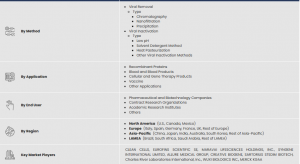Global Viral Clearance Market: Trends, Segmentation, and Future Prospects
What Is Viral Clearance and Why Does It Matter?
Viral clearance refers to the process of eliminating or inactivating viruses during the manufacture of biopharmaceuticals and medical products. This step is essential for ensuring product safety in monoclonal antibodies, recombinant proteins, glycoproteins, tissue- and blood-derived products, and even medical devices.
Get a Sample Copy of this Report: https://www.alliedmarketresearch.com/request-sample/A17087
The main reasons viral clearance is critical are:
Risk of Contamination: Biologics and blood products are susceptible to bacterial and viral contaminants introduced during production.
Quality Assurance: Regulatory bodies and consumers demand that biological drugs, vaccines, and blood products meet strict safety standards.
Increasing Product Complexity: New biopharmaceuticals, especially gene and cell therapies, are more vulnerable to contamination and require more stringent safety protocols.
Key Growth Drivers
Several factors are accelerating the global viral clearance market:
Booming Biopharma Industry: Rapid innovation and an increasing number of monoclonal antibodies, recombinant therapeutics, vaccines, and cell/gene therapies under development.
Regulatory Demands: Stringent safety regulations require validated viral clearance for all biopharmaceuticals.
Rise in Chronic Diseases: Increasing demand for biologics and vaccines as chronic disease incidence grows worldwide.
Mergers and Partnerships: Strategic alliances—such as Merck KGaA's partnership with Pfizer Inc. for BAVENCIO and Clean Cells' collaboration with NAOBiOS—are expanding market capabilities and offerings.
Despite these positives, the market may face challenges such as industry consolidation, which can concentrate power among a few big service providers, potentially raising costs and limiting flexibility.
Major Market Segments
1. By Method
Viral Removal: Includes chromatography, nanofiltration, and precipitation. This segment dominates due to established use and proven reliability.
Viral Inactivation: Methods include low pH, solvent detergent, heat pasteurization, and other innovative techniques.
2. By Application
Recombinant Proteins: Largest share in 2021—growing demand as chronic illness and biologic development increase.
Cellular and Gene Therapy Products: Fastest growing—reflecting a surge in clinical trials and investment in next-generation therapeutics.
Vaccines, Blood & Blood Products: Also significant contributors due to volume and regulatory scrutiny.
3. By End User
Pharmaceutical & Biotechnology Companies: Dominant contributors due to in-house production of biopharmaceuticals.
Contract Research Organizations (CROs): Rapid growth expected as drug makers increasingly outsource viral clearance and product validation studies.
Academic Institutes: Involved in early-stage research and method development.
Regional Insights
North America: Leads the market with high demand for biologics, advanced purification technologies, and favorable policies supporting biopharma innovation.
Asia-Pacific: Anticipated to grow fastest, fueled by expanding R&D, increasing government support, a growing skilled workforce, and rapid expansion of the local biopharmaceutical industry.
Europe and LAMEA: Also seeing steady growth due to rising investments and regulatory modernization.
Competitive Landscape
Key companies shaping the viral clearance market include:
Allure Medical Group
Charles River Laboratories International, Inc.
Clean Cells
Creative Biogene
Eurofins Scientific SE
Maravai Lifesciences Holding, Inc.
Merck KGaA
Sartorius Stedim Biotech
Syngene International Limited
Wuxi Biologics Inc.
These organizations are focusing on technological innovation, merger and acquisition strategies, and expanded global footprints to meet mounting demand.
The Future of Viral Clearance
As the pipeline of complex biologics and personalized medicines continues to expand, viral clearance will become even more integral to biomanufacturing. Investments in rapid, reliable, and scalable clearance technologies alongside global harmonization of safety standards will define the next decade of growth.
The expanding application in cell and gene therapies, coupled with persistent innovation in removal and inactivation methods, ensures the market's sustained momentum—offering new opportunities for specialized service providers, technology innovators, and contract research organizations worldwide.
Enquire Before Buying: https://www.alliedmarketresearch.com/purchase-enquiry/A17087
David Correa
Allied Market Research
+ + 1 800-792-5285
email us here
Visit us on social media:
LinkedIn
Facebook
YouTube
X
Legal Disclaimer:
EIN Presswire provides this news content "as is" without warranty of any kind. We do not accept any responsibility or liability for the accuracy, content, images, videos, licenses, completeness, legality, or reliability of the information contained in this article. If you have any complaints or copyright issues related to this article, kindly contact the author above.
Aerospace Additive Manufacturing Market 2025-2029: Unveiling Growth Developments with the Latest Updates
Aerospace Engineering Services Outsourcing Market is Projected to Increase at a CAGR of 18.7% Through 2025-2029
J3 Bioscience Appoints Qun Xu as Head of Finance to Support Growth and Drive Visibility for Women’s Health Innovation
Więcej ważnych informacji
 Jedynka Newserii
Jedynka Newserii

 Jedynka Newserii
Jedynka Newserii

Konsument

Tylko 35 proc. Celów Zrównoważonego Rozwoju ONZ możliwe do osiągnięcia przed 2030 r. Potrzebna ściślejsza współpraca międzynarodowa
Jak wynika z raportu ONZ, choć w ciągu ostatniej dekady dzięki dążeniu do realizacji przyjętych celów udało się poprawić życie milionów ludzi na całym świecie, to jednak tempo zmian pozostaje zbyt wolne, by dało się je osiągnąć do 2030 roku. Postęp hamują przede wszystkim eskalacja konfliktów, zmiana klimatu, rosnące nierówności i niewystarczające finansowanie. Jak wynika ze sprawozdania Parlamentu Europejskiego, problemem jest także brak ścisłej współpracy międzynarodowej i sceptyczne podejście niektórych państw ONZ.
Przemysł spożywczy
UNICEF: Wszystkie dzieci poniżej piątego roku życia w Gazie cierpią z powodu niedożywienia. Sytuacja jest katastrofalna

Ataki Izraela na Strefę Gazy i jej izolacja doprowadziły do całkowitego załamania podstawowych usług i ograniczenia możliwości dostaw i dystrybucji pomocy humanitarnej – wskazuje UNICEF. W efekcie setki tysięcy Palestyńczyków są w sytuacji ciągłego zagrożenia życia i cierpią z powodu niedożywienia i głodu. Ta klęska dotyczy praktycznie wszystkich dzieci poniżej piątego roku życia. Konflikty są jednym z głównych przyczyn braku bezpieczeństwa żywnościowego, głodu i niedożywienia na świecie. Szczególnie dotyczy to Afryki i Azji Zachodniej.
Prawo
Branża ciepłownictwa czeka na unijną i krajową strategię transformacji. Liczy na większe fundusze i korzystne regulacje

Komisja Europejska zapowiedziała rozpoczęcie w I kwartale 2026 roku prac nad strategią dla ciepłownictwa i chłodnictwa. Nad tym strategicznym dokumentem w zakresie ciepłownictwa pracuje także polski rząd. Branża podkreśla, że obie te strategie będą miały kluczowe znaczenie dla trwającej transformacji w ciepłownictwie, czyli przyszłości ogromnych inwestycji, które czekają sektor do 2050 roku. Jednocześnie apeluje o większe wsparcie tego procesu ze środków publicznych.
Partner serwisu
Szkolenia

Akademia Newserii
Akademia Newserii to projekt, w ramach którego najlepsi polscy dziennikarze biznesowi, giełdowi oraz lifestylowi, a także szkoleniowcy z wieloletnim doświadczeniem dzielą się swoją wiedzą nt. pracy z mediami.


![Nestlé w Polsce podsumowuje wpływ na krajową gospodarkę. Firma wygenerowała 0,6 proc. polskiego PKB [DEPESZA]](https://www.newseria.pl/files/1097841585/fabryka-nesquik_1,w_85,r_png,_small.png)






.gif)

 |
| |
| |
|